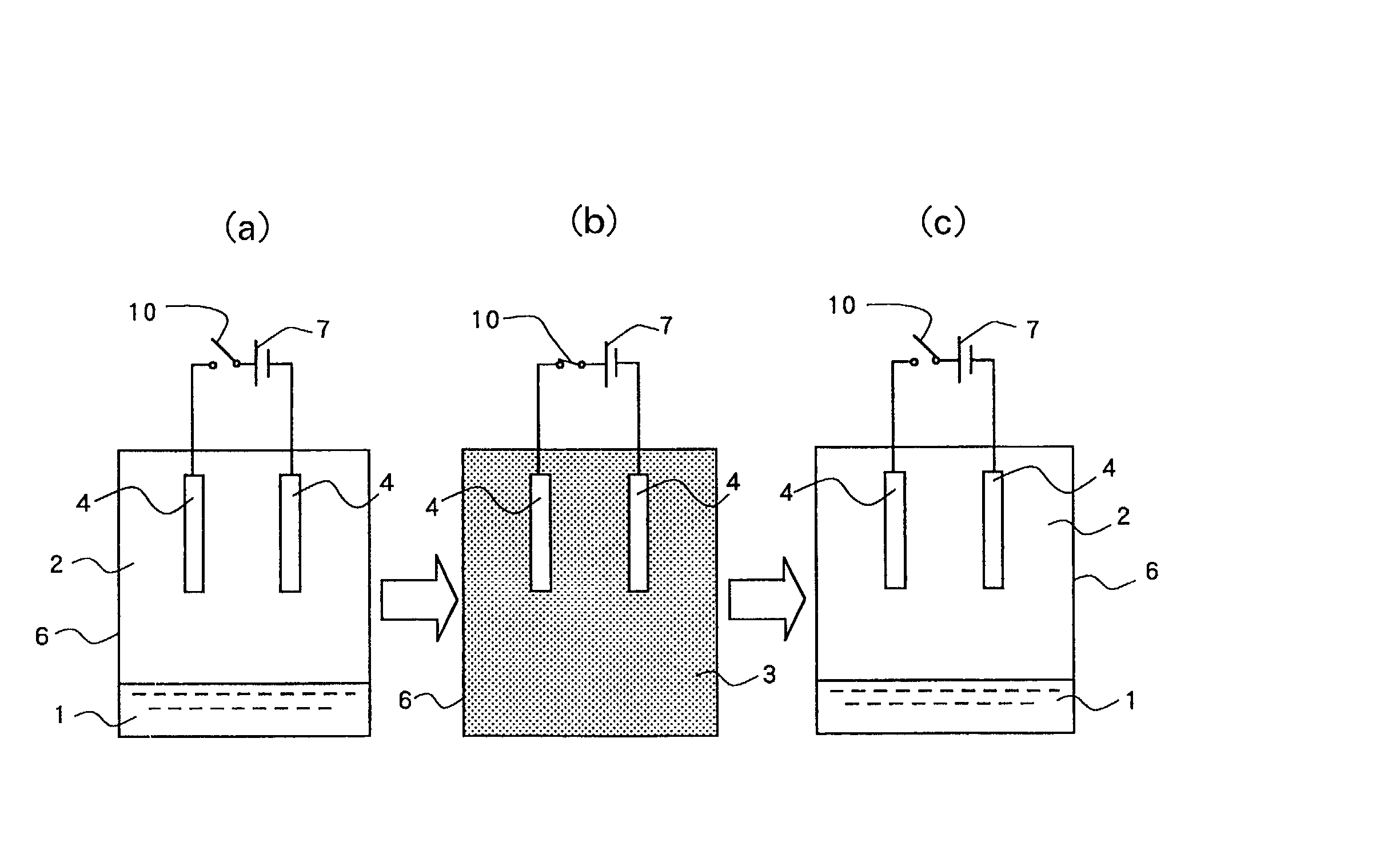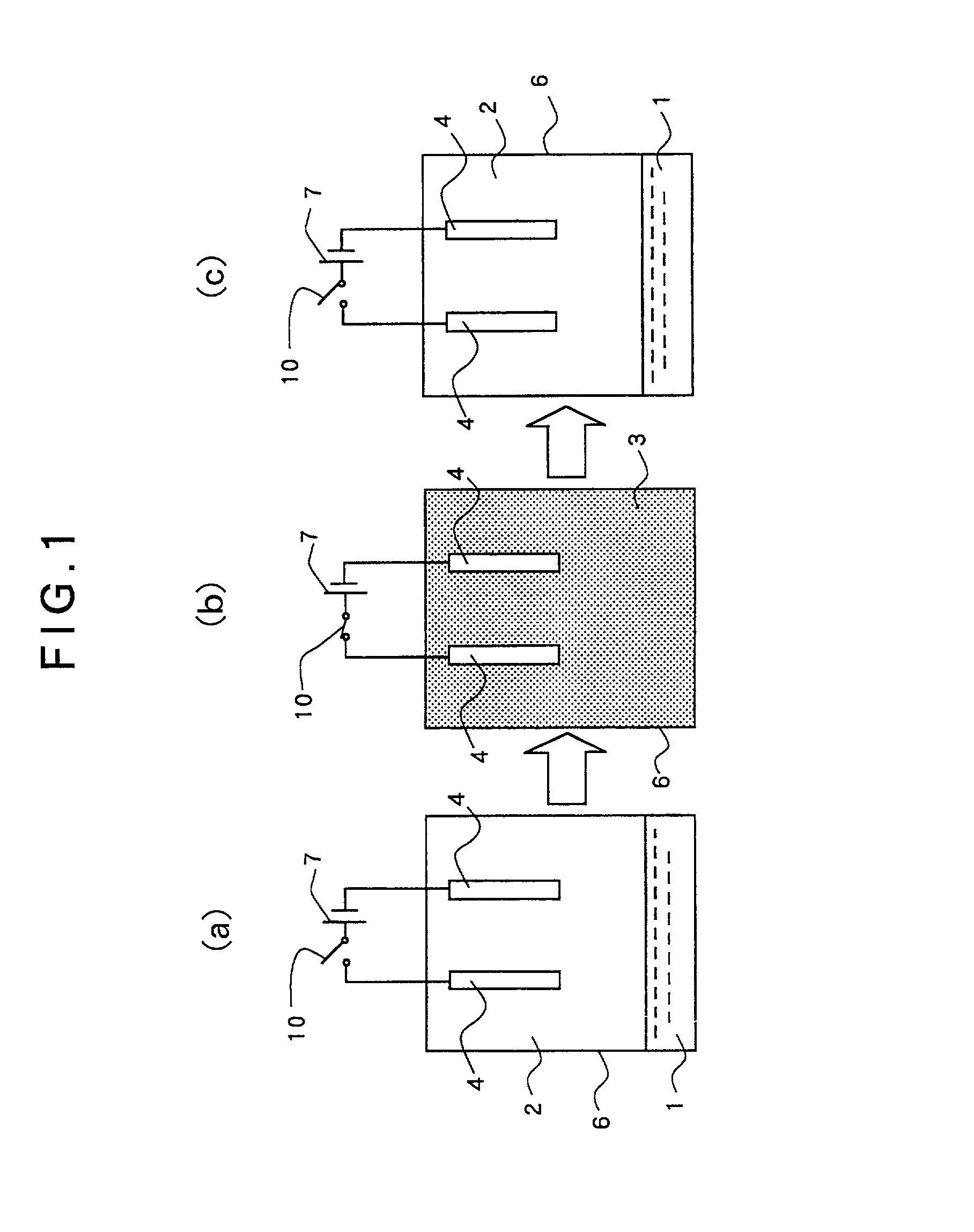Electrochemical treating method such as electroplating and electrochemical reaction device therefor
a technology of electrochemical treatment and electrochemical reaction, which is applied in the direction of electrochemical machining apparatus, surface reaction electrolytic coating, crystal growth process, etc., can solve the problems of large scale, ineffective use of surface active agent, and inability to treat liquid waste, so as to reduce the amount of liquid waste to be treated, the diffusion constant is high, and the effect of enhancing the reactability
- Summary
- Abstract
- Description
- Claims
- Application Information
AI Technical Summary
Benefits of technology
Problems solved by technology
Method used
Image
Examples
specific example 2
[0167] A pure copper plate was used for the anode electrode and a Hull cell test-use brass plate was used for the cathode electrode, and electroplating was carried out. A copper cyanide bath was used as the electrolytic solution. Its composition is shown hereunder.
[0168] [Plating Bath Composition]
3 primary copper cyanide: 30 g / l sodium cyanide: 45 g / l (free sodium cyanide): 15 g / l sodium carbonate: 15 g / l pH: 12.5
[0169] As the surface active agent, block polymer (PEO-PBO, molecular weight=860-b-660 g / mol) of polybutyleneoxide-polyethyleneoxide was added by 1.5 wt % based on the above electrolytic solution.
[0170] Carbon dioxide was used as the matter to be shifted into a supercritical state, and the volume ratio of the electrolytic solution and the carbon dioxide was set to 1 / 2 under the normal pressure. Reaction was carried out for 10 minutes under the conditions of temperature of 50 degrees C. (323 K), pressure of 15 MPa and electric current density of 5 A / dm.
[0171] As a result, a ...
specific example 3
[0175] A zinc plate was used for the anode electrode and a Hull cell test-use brass plate was used for the cathode electrode, and electroplating was carried out. A zincate bath was used as the electrolytic solution. Its composition is shown hereunder.
[0176] [Plating Bath Composition]
5 zinc oxide: 40 g / l sodium hydroxide: 180 g / l pH: 5.1
[0177] As the surface active agent, block polymer (PEO-PBO, molecular weight=860-b-660 g / mol) of polybutyleneoxide-polyethyleneoxide was added by 1.5 wt % based on the above electrolytic solution.
[0178] Carbon dioxide was used as the matter to be shifted into a supercritical state, and the volume ratio of the electrolytic solution and the carbon dioxide was set to 1 / 2 under the normal pressure. Reaction was carried out for 10 minutes under the conditions of temperature of 50 degrees C. (323 K), pressure of 15 MPa and electric current density of 5 A / dm. As a result, a uniform zinc film was formed on the surface of the cathode electrode with a good powe...
specific example 4
[0182] A copper plate was used for the anode electrode and a Hull cell test-use brass plate was used for the cathode electrode, and electroforming was carried out. A copper sulfate bath was used as the electrolytic solution. Its composition is shown hereunder.
7 copper sulfate: 200 g / l phosphoric acid: 60 g / l hydrochloric acid: 30 mg / l pH: 4.5
[0184] As the surface active agent, block polymer (PEO-PBO, molecular weight=860-b-660 g / mol) of polybutyleneoxide-polyethyleneoxide was added by 1.5 wt % based on the above electrolytic solution.
[0185] Carbon dioxide was used as the matter to be shifted into a supercritical state, and the volume ratio of the electrolytic solution and the carbon dioxide was set to 1 / 2 under the normal pressure. Reaction was carried out for 10 minutes under the conditions of temperature of 50 degrees C. (323 K), pressure of 15 MPa and electric current density of 20 A / dm.
[0186] As a result, a uniform electroformed copper film was formed...
PUM
| Property | Measurement | Unit |
|---|---|---|
| pressure | aaaaa | aaaaa |
| temperature | aaaaa | aaaaa |
| temperature | aaaaa | aaaaa |
Abstract
Description
Claims
Application Information
 Login to View More
Login to View More - R&D
- Intellectual Property
- Life Sciences
- Materials
- Tech Scout
- Unparalleled Data Quality
- Higher Quality Content
- 60% Fewer Hallucinations
Browse by: Latest US Patents, China's latest patents, Technical Efficacy Thesaurus, Application Domain, Technology Topic, Popular Technical Reports.
© 2025 PatSnap. All rights reserved.Legal|Privacy policy|Modern Slavery Act Transparency Statement|Sitemap|About US| Contact US: help@patsnap.com



